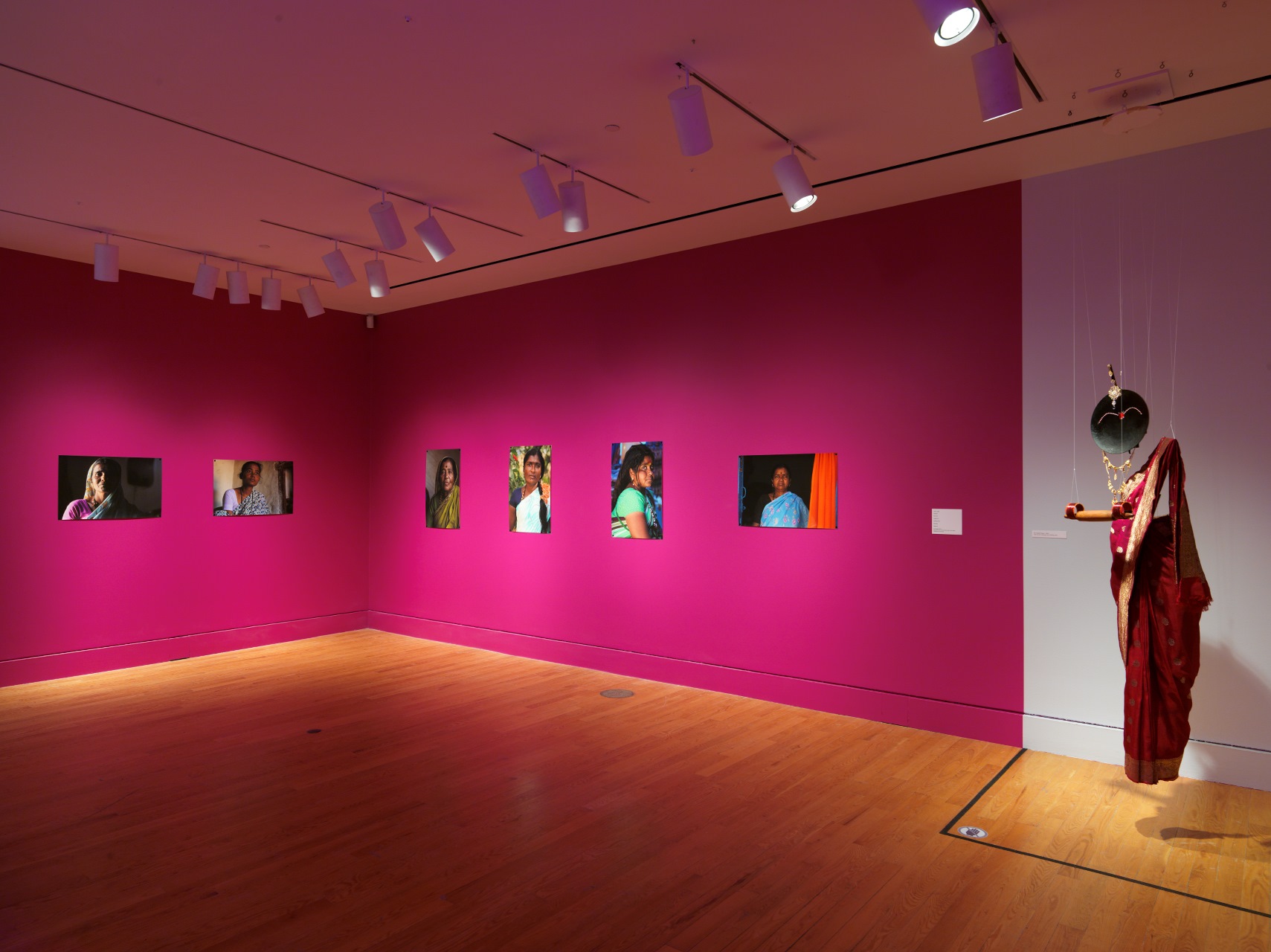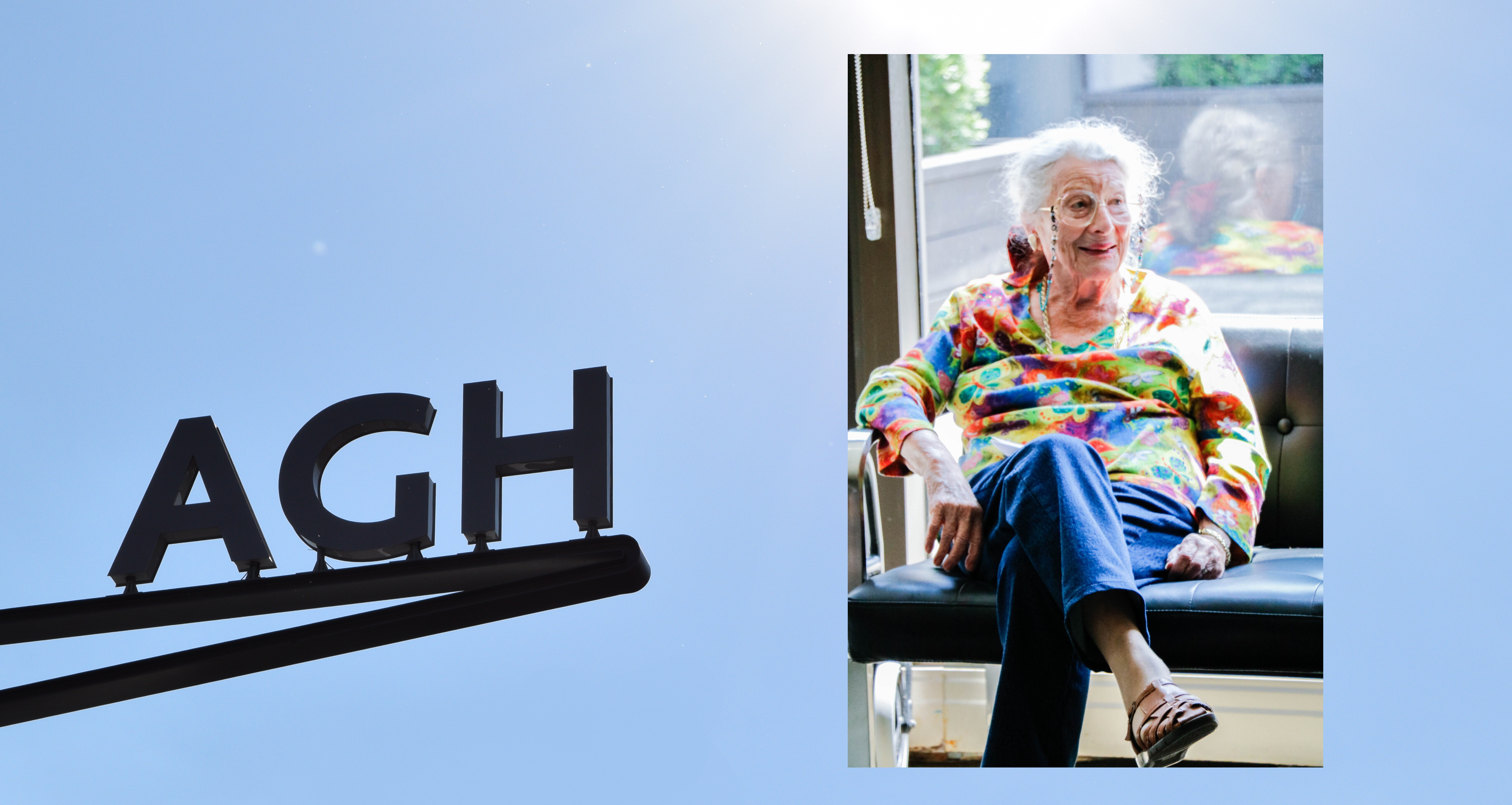Working with living artists affords us the chance to ask them directly about their work and process. In AGH Magazine’s Quest10ns series, we ask contemporary artists whose work is on view at the AGH ten questions on a range of topics to gain insight into what drives their art practice.
‘Touched by Devi’ is a multi-media project and is the first major solo museum exhibition for Hamilton-based artist and playwright Radha S. Menon (she/her).
The exhibition was inspired by her family’s connection to dance. Her mother loved to dance but was never allowed to become a professional dancer, because of the Hindu cultural connection between dance and sex work. When Radha said she wanted to sing, dance, act and attend art school, she was pressured not to and ran away from home at age 16 to become an artist.
In 2019, artist Radha S. Menon travelled deep into rural Karnataka, India—her ancestral country—in search of women who identify as Devadasi. Devadasi, once an honoured practice, birthed India’s great dance forms and allowed high-caste women to resist marital norms through spiritual devotion. However, due to British colonizers who banned this practice, Devadasi women, now exclusively from underprivileged castes, exist as criminalized women artists/sex workers who remain ostracized and open to exploitation.
This exhibition responds to these complex histories of women in colonized India, expressed through portrait photography, interview text, movement, and sculptural installation. These elements come together as part of an ongoing healing journey for the artist, as she explores the history of women’s rights in India in connection with her family history.
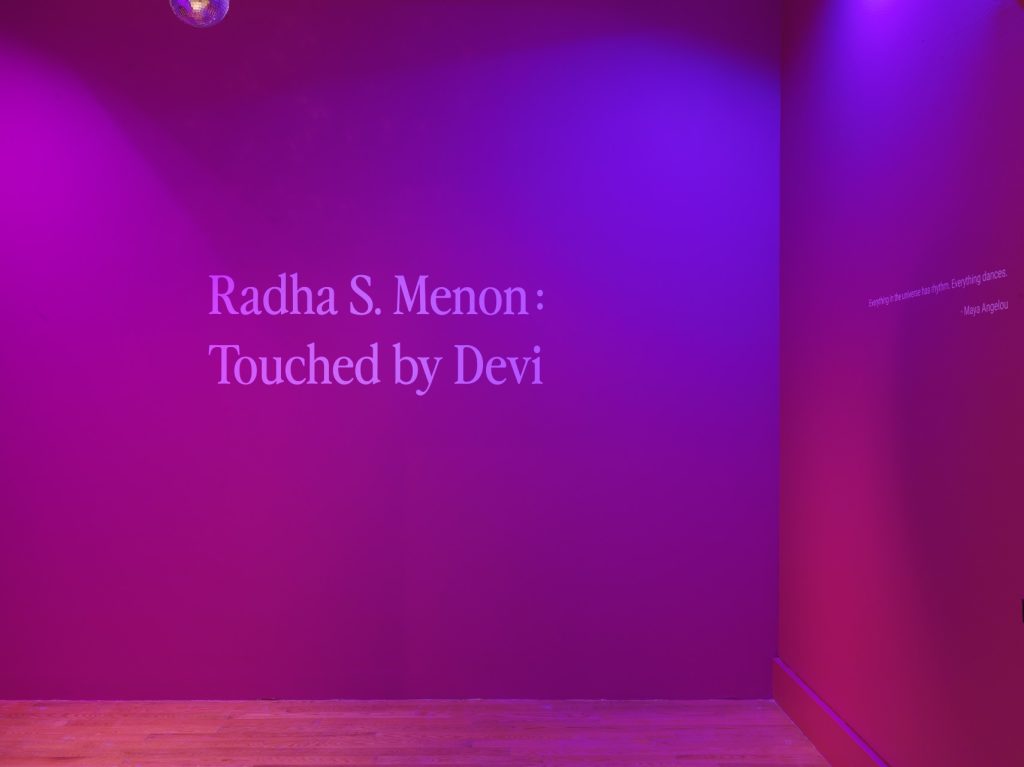
1. How long was the process of putting ‘Touched by Devi’ together, from an idea to a fully formed exhibition?
I began my research for a triptych of plays about Hindu goddesses, (they’re called ‘The Devi Triptych’) in 2018. The documentation that is now a part of the exhibition I recorded in 2018 and 2019. When I recorded all of this footage- video and portrait, recordings and interviews, that’s when I thought, “This would be really great to share.” That’s when I contacted the Gallery about this.
So it’s been… four, five years in the making, and the ideas for what should be a part of it. Melissa Bennett (AGH curator) was interested in connecting it to my own family, and there were those correlations to my own spiritual journey. It was just an incredible time that I had during that research period.
2. Could you describe your art-making process for this exhibition? And was that different than your usual process?
Totally! The majority of art that I make is theatre and it usually starts off with the written word, so this was unusual. I had so many photographs, it was very difficult to pick through them. So, I first put together a drive of about 40 photographs, and so we narrowed it down to about 20 portraits of these ex-Devadasi women. Then we narrowed it down to 12, then I finally picked the six that you see in the show- it was very difficult. It was the same with the family photographs… I was thinking about how to show them. It seemed natural to me that the photographs I choose should tell a story. It was very hard, at times, to do this because it was my own family.
The dance booth was something I came up with from the beginning, the idea of movement. I believe that dance connects us to the universe, energetically. It is well documented in many religions, people dancing- it’s an actual spiritual experience, not a religious one, because religion is dogma and spirituality is something we all have regardless of religion that was prescribed to us as children. I want people to be able to enter the Gallery while experiencing higher vibrations, born of music and dance.
The sculpture – I knew that I wanted to use a wedding Sari and my mother’s tawa, and her rolling pin. It sort of developed organically. I played around with a few different ideas but ended up thinking that it would be great to have this ghost woman, just there, in all her glory. This domestic goddess. Invisible. That was made on-site.
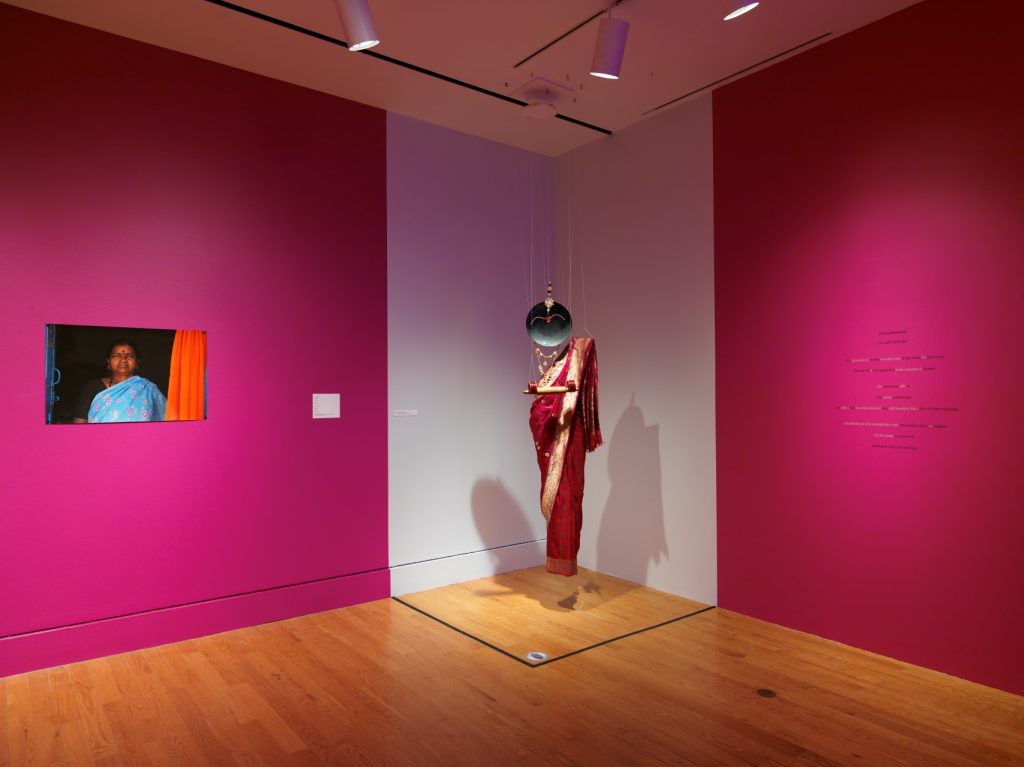
3. What is something you’d like to incorporate into your work moving forwards?
I would love to develop more visual art. I’ve really enjoyed the process. I haven’t had many opportunities to – as a multi-disciplinary artist, you have to choose one and go with that. It seems that the world is not at ease with people being able to practice many art forms. Actually, Miles Davis was an incredibly talented painter, but everybody knows him as a musician. I believe in creative energy; I believe that if you have creative energy you can practice many forms of art. It’s a practice, so I would love to do more sculpture actually.
4. Do you have a favourite piece in the exhibition? And why?
My favourite piece is the personal collage of my family. Mainly because at the end of it, my mother rises as a goddess; it makes my heart sing.
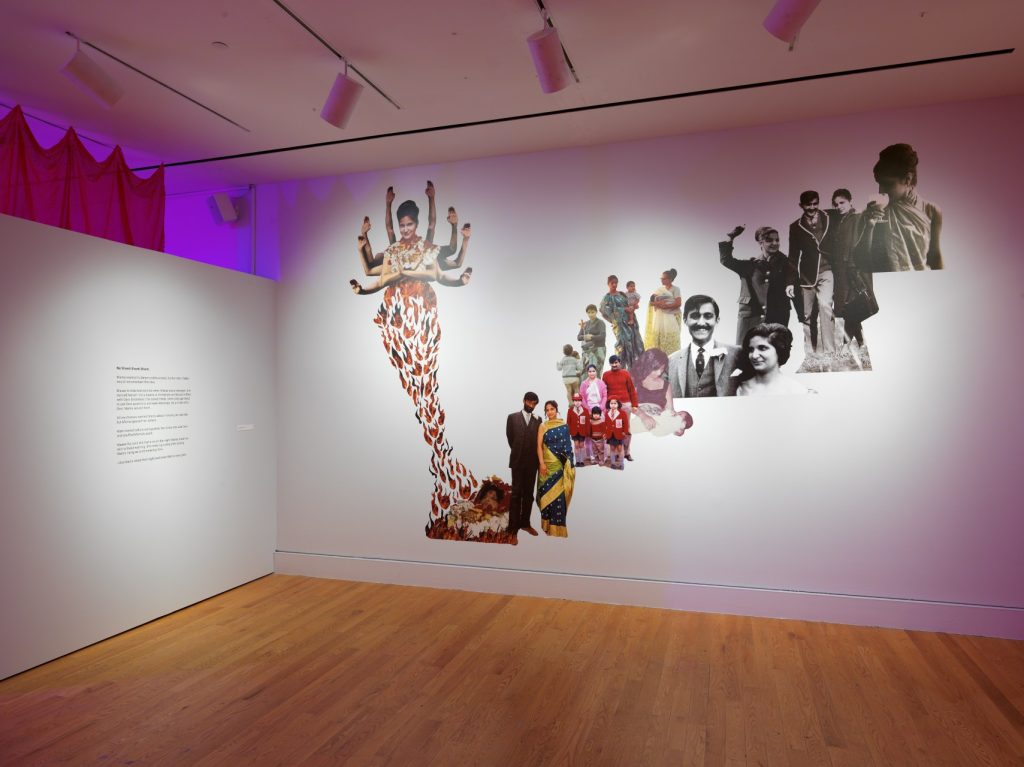
5. You’re sharing this exhibition floor with Jan Wade’s ‘Soul Power,’ and our ‘Director’s Collect’ exhibition- what are your thoughts on the other exhibitions and how do you feel about sharing the floor with them?
First of all, I feel really honoured and privileged to be sharing the space with Jan Wade and her incredible exhibition. It’s such powerful and evocative work- and vital for people to see. Also, all the artists living and gone whose work is populating these galleries, it’s a real pleasure because I am put among them…. it’s a real honour. Especially to the Collection, to Shelley Falconer’s collection- the artists that are in that gallery, and the work, it’s just magnificent. I’m humbled by it, and very grateful that people who flock to see this art will also see my work.
6. What was your family’s reaction to your announcement of the exhibition?
They were very excited! I don’t actually have much family left in Canada. My daughter came in from LA with my granddaughter. I have an aunt and a cousin who came in from St. Thomas, but that’s the extent of my family here. Most of my family are in Europe, so although they were very excited for it, they couldn’t get to see it.
My daughter was floored, she loved it. Loved it. It was great for her to see her grandmother, her grandfather, larger than life on this wall- my mother had passed away before she was born, so she never got to meet her. I felt the spirit of my mother there, and my grandmother is also in those photographs, so there were five generations of us in that gallery that night.
7. What do you hope that visitors take away from this exhibition?
I hope that they see a different perspective. I hope that their curiosity is peaked, and that they see things in different ways. When they have their sugar, they can think about these women who are forced to work as labourers in sugar cane fields because their practice was criminalised. I want people to be able to see that British colonisation changed our culture, and altered it for the worse. Especially for women. It was British misogyny that placed chains around women’s lives in India. That’s what I want people to take away from the art.
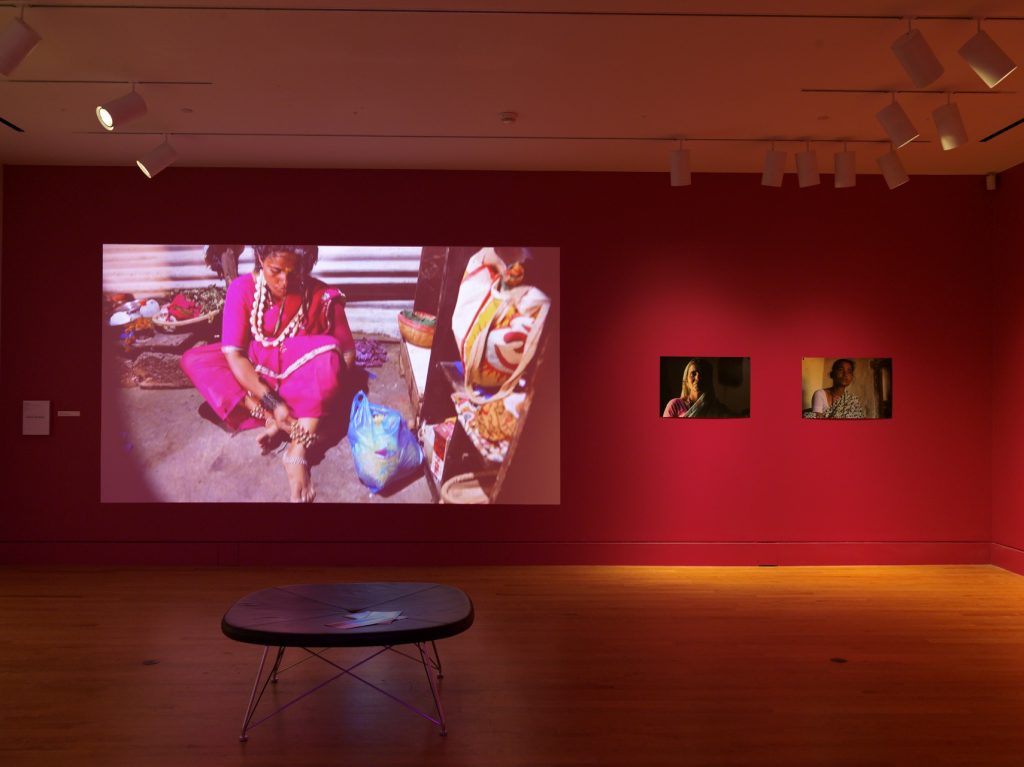
8. Who is an artist who has inspired you recently?
Jan Wade! I’m very inspired by the various mediums and found objects she uses to generate this powerful work. I went through the entire gallery; it’s such an incredible exhibition. I spoke with Jan too; she told me how hard life in Hamilton was and the work in this show was generated over many years. It’s stunning; you must see it.
9. If you weren’t an artist, what would you be?
A chef. Cooking is the only other thing I can do! Or, a traveller maybe. Sit under trees. Somebody who just didn’t have to live in the cities. Live in a caravan, making daily trade, and see the world.
If I had to work I would be a chef. I would make many many things, I would cook tasty vegan food that isn’t based on artificial meat replacements. I don’t understand why people want to be vegan and then want to eat this rubbish – pure gluten and processed – when there’s so much good food that you don’t have to do anything to except cook it. I would cook wholesome, organic, very tasty vegan food.
10. What are you working on next?
Well right now I have a lot of work on my plate. We’re (Red Beti Theatre) in the final stages of development of three plays, called ‘Devi Triptych,’ and they are feminist adaptations of ancient Indian literature.
So, one of them is called ‘Sita’s Revenge,’ which is an adaptation of ‘Ramayana.’ The second one is called ‘Brick Lane Bargain,’ and it’s the Radha/Krishna love story. The third one, A Pot Made of Sand, which most of the research work from within the Gallery is about Renuka/Yellamma, who is the goddess of all these dispossessed ex-Devadasi women. So it’s the creation myth coming from the 3rd gender (or transgender perspective), their myth is dramatised into a musical. So right now, we have a month-long workshop at Brock U, then next year it will be produced in Hamilton at Dundurn Castle in August in partnership with Tottering Biped Theatre. Look out for that!
India has an unbroken tradition of the Devi (Mother Goddess) culture for over 5000 years. While the Olympian gods dislodged the ancient Minoan earth goddess, the tradition of Devi, celebrated in many forms (Durga, Kali, Saraswati) remains intact. While patriarchy creates a social framework invested with male superiority and voice, the maternal feminine identification remains the psychic bedrock of society but is often not apparent on the surface.
When Europeans arrived in India in the 16th century, they could not appreciate goddess Kali’s appearance; her nakedness, unbound hair, unbridled lust, thirst for blood and outstretched tongue while dominating the prone deity, Shiva. This image was so far removed from the virginal Mary that Europeans were terrified by Kali and presumed that all natives were savages.
Four hundred years of colonialism almost wiped-out Devi culture; we want to remedy that by presenting a substantial work of art that will eventually cross continents and underscore the importance of the female experience.
Controlling the narrative is power. That’s why politicians have always been adept at curating truth to craft stories that justify ruthless self-serving actions. Today we are witnessing the same evil propaganda to justify the degradation of Gaza and the extermination of the Palestinian people. The simple fact that the state of Israel was carved out of Palestine by Western powers for European Jews to occupy, has been cloaked in falsehood and propaganda that has dehumanized the Arab population. If Russia were doing the same in Ukraine, which is another awful situation, you can be sure that Canadian banks, companies and leaders wouldn’t be servicing the Russians.
All that to say, that in the case of feminine power, aspersions against womanhood and a consistent narrative trying to diminish the feminine divine and women’s agency has distorted the truth- we are powerful beings that cannot be cowed.
I am also working on Red Beti Theatre’s new play festival – an annual festival called ‘Decolonise Your Ears’ where we develop three new plays written by Indigenous, Black, or other racialised women, emerging playwrights. We help them develop their plays and then these plays are staged at Theatre Aquarius. They have readings with professional directors and actors, so right now we’re just working with playwrights.
Devi Triptych will be presented in 2025 outdoors at Dundurn Castle, and Decolonise Your Ears New Play Festival 2024 will be held at Theatre Aquarius from October 1-6. Follow @redbetitheatre or @lal_beti for updates!
Radha S. Menon’s work is on view now until January 5, 2025. Find ‘Touched by Devi’ on the first floor of the AGH.
